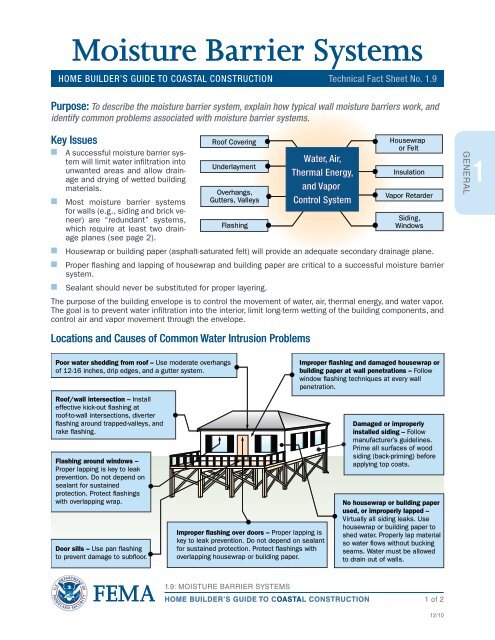FEMA P-499: Home Builder's Guide to Coastal Construction
FEMA P-499: Home Builder's Guide to Coastal Construction
FEMA P-499: Home Builder's Guide to Coastal Construction
You also want an ePaper? Increase the reach of your titles
YUMPU automatically turns print PDFs into web optimized ePapers that Google loves.
Moisture Barrier Systems<br />
HOME BUILDER’S GUIDE TO COASTAL CONSTRUCTION Technical Fact Sheet No. 1.9<br />
Purpose: To describe the moisture barrier system, explain how typical wall moisture barriers work, and<br />
identify common problems associated with moisture barrier systems.<br />
Key Issues<br />
n A successful moisture barrier system<br />
will limit water infiltration in<strong>to</strong><br />
unwanted areas and allow drainage<br />
and drying of wetted building<br />
materials.<br />
n Most moisture barrier systems<br />
for walls (e.g., siding and brick veneer)<br />
are “redundant” systems,<br />
which require at least two drainage<br />
planes (see page 2).<br />
n Housewrap or building paper (asphalt-saturated felt) will provide an adequate secondary drainage plane.<br />
n Proper flashing and lapping of housewrap and building paper are critical <strong>to</strong> a successful moisture barrier<br />
system.<br />
n Sealant should never be substituted for proper layering.<br />
The purpose of the building envelope is <strong>to</strong> control the movement of water, air, thermal energy, and water vapor.<br />
The goal is <strong>to</strong> prevent water infiltration in<strong>to</strong> the interior, limit long-term wetting of the building components, and<br />
control air and vapor movement through the envelope.<br />
Locations and Causes of Common Water Intrusion Problems<br />
Poor water shedding from roof – Use moderate overhangs<br />
of 12-16 inches, drip edges, and a gutter system.<br />
Roof/wall intersection – Install<br />
effective kick-out ashing at<br />
roof-<strong>to</strong>-wall intersections, diverter<br />
ashing around trapped-valleys, and<br />
rake ashing.<br />
Flashing around windows –<br />
Proper lapping is key <strong>to</strong> leak<br />
prevention. Do not depend on<br />
sealant for sustained<br />
protection. Protect ashings<br />
with overlapping wrap.<br />
Door sills – Use pan ashing<br />
<strong>to</strong> prevent damage <strong>to</strong> suboor.<br />
Roof Covering<br />
Underlayment<br />
Overhangs,<br />
Gutters, Valleys<br />
Flashing<br />
1.9: MOISTURE BARRIER SYSTEMS<br />
Water, Air,<br />
Thermal Energy,<br />
and Vapor<br />
Control System<br />
Improper flashing over doors – Proper lapping is<br />
key <strong>to</strong> leak prevention. Do not depend on sealant<br />
for sustained protection. Protect ashings with<br />
overlapping housewrap or building paper.<br />
HOME BUILDER’S GUIDE TO COASTAL CONSTRUCTION<br />
Housewrap<br />
or Felt<br />
Insulation<br />
Vapor Retarder<br />
Siding,<br />
Windows<br />
Improper flashing and damaged housewrap or<br />
building paper at wall penetrations – Follow<br />
window ashing techniques at every wall<br />
penetration.<br />
Damaged or improperly<br />
installed siding – Follow<br />
manufacturer’s guidelines.<br />
Prime all surfaces of wood<br />
siding (back-priming) before<br />
applying <strong>to</strong>p coats.<br />
No housewrap or building paper<br />
used, or improperly lapped –<br />
Virtually all siding leaks. Use<br />
housewrap or building paper <strong>to</strong><br />
shed water. Properly lap material<br />
so water ows without bucking<br />
seams. Water must be allowed<br />
<strong>to</strong> drain out of walls.<br />
1 of 2<br />
12/10<br />
GENERAL<br />
1


